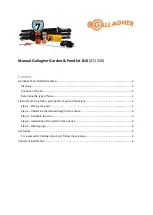
10 |
S3 Cell Sorter Instruction Manual
10 |
2.3.2 Beam Shaping Optic (BSO)
The beam shaping optic sits in between the laser(s) and the interrogation point. This serves to
shape and focus the laser beam(s) to optimize the illumination of the cell.
2.3.3 Interrogation
The interrogation point is the point at which the laser beam(s) intercepts the core stream of
the sample. At this point, light is scattered around each individual particle and the particle
fluoresces if any fluorophores are attached.
2.3.4 Light Collection
Light is collected from two directions, forward and side angle. The light can be categorized into
two types — scattered and fluorescent. Scattered light refers to the wavelength of light coming
from the laser, which is scattered when a particle is encountered. Fluorescent light refers to the
light emitted by the fluorophores or dyes attached to the particle or cell after excitation from the
laser. This emitted light is of a higher wavelength than the excitation light and therefore can be
separated and detected using optical filters.
2.3.5 Forward Scatter
Light coming around the particle in the forward direction (same plane as the laser beam) is
collected to give an indication of particle size. By default, the scattered laser light is collected,
but fluorescent light could be collected by changing the filter.
2.3.6 Optical Filters
Optical filters are coated pieces of glass used to divide the spectrum of light into bands for
analysis. By separating and detecting different bands of light, it is possible to understand
multiple properties of each particle.
IMPORTANT!
When removing or replacing filters, wear gloves to avoid depositing
smudges and fingerprints on the glass surfaces. Please see Section 10.5, Optical
Filter Cleaning, for specific instructions on cleaning optical filters.
2.3.7 Photomultiplier Tubes (PMTs)
The PMTs are used to detect and amplify the light signals coming from each particle. They are
located behind the optical filters to detect specific bands of light based on the fluorophores that
are attached to the cell.
2.3.8 Cameras
The S3 system contains several cameras for system alignment and calibration. The function of
each of these cameras is detailed below.
Note:
Cameras do not require adjustments by users.
n
Pinhole camera
— aligns the stream and laser to the optical detection path. This camera is
viewable only by service personnel and during the nozzle tip swap process
n
Droplet camera
— calibrates the droplets and maintains the drop delay. The image of the
break-off can be visualized in the software through the Droplet Monitor option on the home tab
n
Streams camera
— calibrates the side streams and aligns them with the collection tubes. This
camera can be visualized in the software through the View Streams option on the home tab
Содержание 145-1001
Страница 1: ...S3 Cell Sorter Instruction Manual Catalog 145 1001 145 1002...
Страница 2: ......
Страница 8: ...S3 Cell Sorter Instruction Manual vi vi...
Страница 10: ...S3 Cell Sorter Instruction Manual viii...
Страница 22: ...12 S3 Cell Sorter Instruction Manual 12...
Страница 42: ...S3 Cell Sorter Instruction Manual 32...
Страница 60: ...50 S3 Cell Sorter Instruction Manual 50...
Страница 74: ...S3 Cell Sorter Instruction Manual 64...
Страница 82: ...72 S3 Cell Sorter Instruction Manual 72...
Страница 96: ...86 S3 Cell Sorter Instruction Manual 86...
Страница 112: ...102 S3 Cell Sorter Instruction Manual 102...
Страница 114: ...S3 Cell Sorter Instruction Manual 104...
Страница 116: ...106 S3 Cell Sorter Instruction Manual 106...
Страница 118: ......
Страница 119: ......
















































